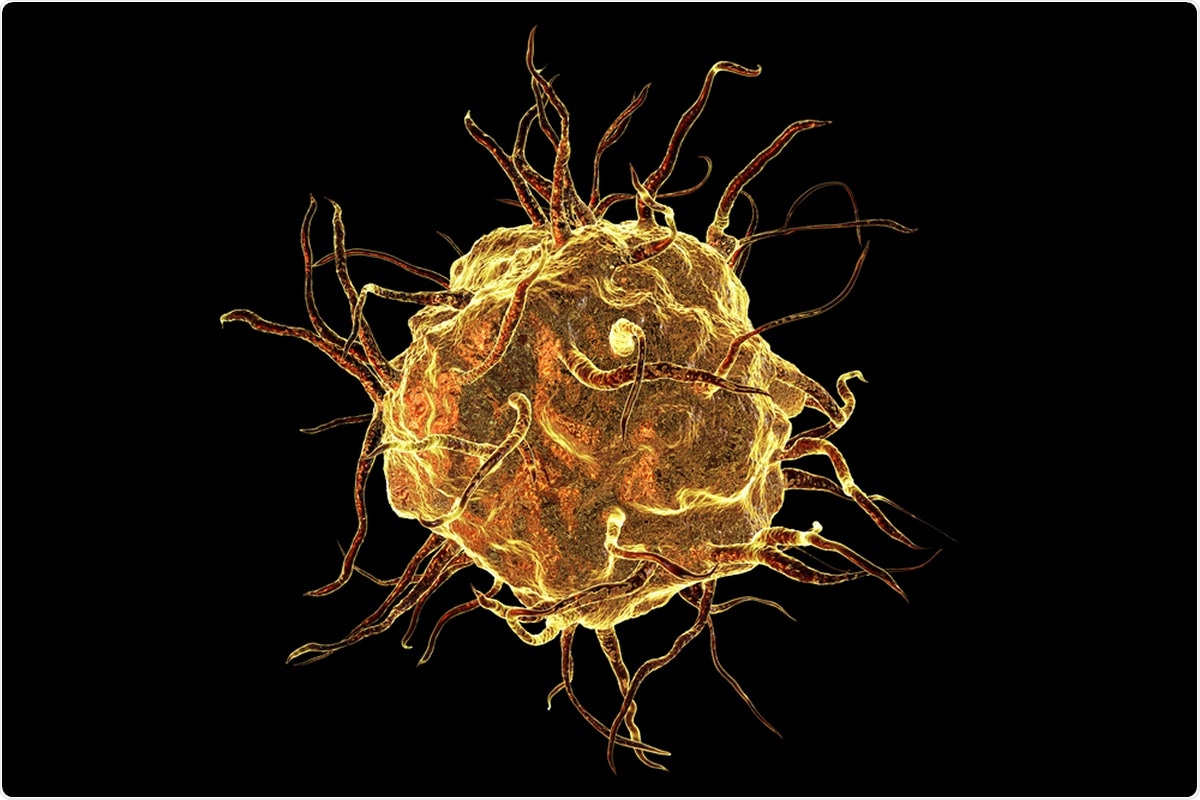Many researchers are attempting to identify risk factors for severe or critical COVID-19. A recent paper in the journal Medical Hypotheses in September 2020 suggests that macrophage class activation is one of the factors that determine the clinical phenotype of severe acute respiratory syndrome coronavirus 2 (SARS-CoV-2) infection.

Macrophage cell isolated on black background, monocyte, close-up view of immune cell, 3D illustration. Image Credit: Kateryna Kon / Shutterstock
Lung macrophages reach this organ in three successive waves at various stages of development. Macrophages in children and in adults must be compared in order to understand how the severity of the disease varies with the degree of development of the macrophage population.
Many studies demonstrate that a sustained rise in IL-6 and IL-1 are linked to poor survival odds in adult respiratory distress syndrome (ARDS), which is a classic feature of severe or critical COVID-19. The latter condition is characterized by the systemic hyper-inflammation called the cytokine storm, or macrophage activation syndrome (MAS).
On the other hand, children are not so susceptible to severe forms of COVID-19, as in Italy, where almost 28,000 patients died, but only 3 below 18 years, as of May 13, 2020. These figures gain relevance when compared to the total number of COVID-19 patients, at ~214,000, and that of pediatric patients, at ~4,500.
Older Adults at Higher Risk of Severe COVID-19
Older people seem to be at a higher risk of death due to COVID-19 because of lower immune function with aging, and this may lead to dysregulation and a cytokine storm.
On the other hand, the apparent protection of children against death due to this infection has been ascribed to a variable pattern of angiotensin converting enzyme 2 (ACE2) receptors in this group, with the level of ACE2 expression in the lung tissue being reduced. However, this is still hypothetical. Moreover, says the author, this would promote rather than protect against a cytokine storm, since the SARS-CoV-2 infection acts via this mechanism.
ACE2 Downregulation Indicates a Poor Prognosis
When ACE2 expression is lowered, the ratio of ACE/ACE2 goes up, which is a poor prognostic factor in lung disease and is also a marker of many chronic illnesses that are linked to a poor outcome in COVID-19. In any case, there does not seem to be any association with the age of the patient and the ACE2 level in bronchoalveolar lavage fluid in earlier studies.
A 2016 paper shows the three waves of macrophages populating the lungs. The first two occur during intrauterine development, in mice, and the third in postnatal life. Thus, children may be expected to have more of the first two lineages of macrophage cells.
Each of these can be traced down to different macrophage groups in the mature lung, with varying cell membrane markers. Some research indicates that ACE2 is not found on all macrophages. The three types of macrophages in the lung do not switch between each other but do interact during immune responses.
Different Macrophage Subgroups React Differently to Infection
The effect of this is that at different ages, the three subgroups of macrophages may mediate a different inflammatory and immune response following exposure to the same antigens. This is especially so with respiratory pathogens, which are countered to a large extent by macrophages in the early phase. The author comments that this “may explain the range of clinical scenarios from asymptomatic, to cold-like symptoms or to dramatic pneumonia.”
The coronavirus spike antigen elicits a human monocyte/macrophage response in vitro via the NF-kappaB pathway, though this finding comes from a study of a single macrophage population. In addition, tissue macrophages resident in the lungs, the memory T cells of the lung, might be cross-reactive to the virus and may facilitate rapid viral clearance. Thus, their presence may prevent progressive COVID-19 by reducing the level of lung inflammation, endothelial damage, and the build-up of macrophages to dangerous proportions.
Different macrophages populations may be similarly found in other organ targets, such as the heart, where the intracardiac fibroblasts or macrophages are necessary for myocardial damage to occur.
Mechanisms Yet to be Uncovered
Some studies suggest that the virus modulates NLRP3 inflammasome activation, which leads to the recruitment of macrophages and leads to widespread damage to the alveoli. The interaction of the inflammasome with the ACE2 receptor may vary with the specific population of macrophages. This may be worth investigating to understand how old vs. young patients with COVID-19 react to the infection.
Patients with severe COVID-19 who required Intensive Care Unit (ICU) care also had a higher proportion and the absolute number of peripheral blood mononuclear cells with CD14+ CD16+ markers, indicating the production of the inflammatory cytokine IL-6.
Other proposed mechanisms underlying the distinctive patterns of lethality in young and old patients with COVID-19 include the absence of involvement of the heart, lung alveoli, and kidneys, different levels of expression of ACE2 and TMPRSS2, as well as a variation in the immune response, which inhibits hyper-inflammatory pathways. These may be linked to the different patterns of macrophages in the lung at various periods of human life.
Implications
In view of the speculative importance of these differences, the study concludes, “Macrophages play a pivotal role in determining COVID-19 severity, but the consequences of macrophage activation in different cell populations are still speculations. More experiments are needed.”
Source